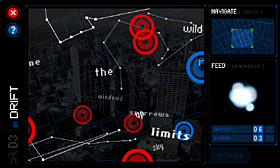From stop-motion narrative to public authoring kiosk
 In April 2002 c2o/Toy Satellite's Artistic Director, Andrew Garton, was commissioned by the Australian Centre for the Moving Image (ACMI) to design and produce a public interactive for the Memory Grid, a community media exhibition and access space. The result of 8 months research and design specifications was D3, then described as “A Prototype Stop-motion Narrative”.
In April 2002 c2o/Toy Satellite's Artistic Director, Andrew Garton, was commissioned by the Australian Centre for the Moving Image (ACMI) to design and produce a public interactive for the Memory Grid, a community media exhibition and access space. The result of 8 months research and design specifications was D3, then described as “A Prototype Stop-motion Narrative”.
In December 2002 production commenced on the prototype. Although not all expectations of the project were to be met within the time frame and budget, the D3 prototype was completed in June 2003 and available for broad public participation in testing and evaluation.
The D3 prototype invited participants to explore a unique map of the Melbourne CBD, a map created by people who participated in pre-prepared workshops and organised into Dérive Teams1.

Each Team was given a simple algorithm with which they navigated the city by. The algorithm would have them stop at intervals from where they would photograph, video and comment on what they found there. They would then repeat the algorithm and move on.
The end result of these excursions was a GPS defined map, the coordinates of which were converted to a vector format which in turn formed the basis of D3's interface. The Dérive Teams also collected still images, video and text which when added to the D3 CMS, populated the main interface screen from which users would review and collect assets.
D3 is a synthesis of projects that have inhabited Toy Satellite since its inception. In fact, the fundamental ideas of D3, as a medium for public authoring go back to Andrew's involvement in community broadcasting in the mid-late 70s, theatre works in the 80s and computer networks in the 90s. He saw modems as a means for readers to become publishers, for consumers to be less consumed and more engaged in the cultural life of their communities.
As such D3 can be seen as a technology bridge. A means by which artifacts of ones anecdotal and/or cultural life may be mapped (at the users discretion of course), stored, retrieved and shared well beyond the life-span of a domain name, let alone the servers that carry the world's precious digital resources.
D3 is currently based in Melbourne, but Toy Satellite is keen to develop the application for use any where. Related projects would map individual regions, towns, villages, a school yard, a farm from which GPS coordinates would compile an interface on which photos, video clips and text could be appended.
Toy Satellite sees D3 engaging the benevolent interests of telecommunications providers towards the establishment of Public Authoring Kiosks in both urban and rural communities, its resources available across mediums, syndicated to like-initiatives (eg. Urban Tapestries2) world-wide.
D3 could also disseminate that content back out via wireless, annotating the virtual space with the materials it receives, curated or otherwise. The content would be available to those with wireless handhelds, or for those without, they could go into ACMI or where ever we have a Public Authoring Kiosk to add content, celebrate a birthday for example, towards a kind of community, moderated (to an extent) weblog of considerable social and cultural value.
Project links:
- D3 at ACMI
http://www.acmi.net.au/d3.jsp - Photos from the first exhibition/installation
http://www.toysatellite.org/agarton/photos/D3/
References:
- Interfacing Real and Virtual Environments (1999)
http://www.random.org/mads/publications/ecoop99moo.html - Theory of the Dérive (1956)
http://library.nothingness.org/articles/SI/en/display_printable/314 - Urban Tapestries
http://urbantapestries.net/ - Urban Atmospheres
http://www.urban-atmospheres.net/ - The City as a Process in Time and Space
http://www.urbanicity.org/FullDoc.asp?ID=393 - Urban Drift
http://urbandrift.org/
Comments
D3 was a remarkable experience - the concept of opening it up to wider public authoring and media contribution as part of its next phase is very exciting. Thanks also for the references you have linked in this article - all these experiments have the potential to evolve into tools which will transform our world. Looking forward to more D3!
compositions
gallery
journal
press
projects
sound
stills
text
video
+ Garton's PODCAST
+ Garton's MySpace
+ secession records
SPAA Fringe & CBAA
myspace video
On being an adult
OPEN CHANNEL 21C
Graz Radio Helsinki
Something on the other side
[madebeer1] has left
a week in words
the patton
from old new
Public domain drain
Interview: Australia, where technology plays the role of spoilsport
Punk Commons
Road to Rio
Toy Satellite/Secession
PO Box 1681
Collingwood, 3066, Australia
Tel/Fax: +61 (0) 3 9318 1222
ag @ toysatellite.org
